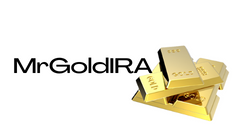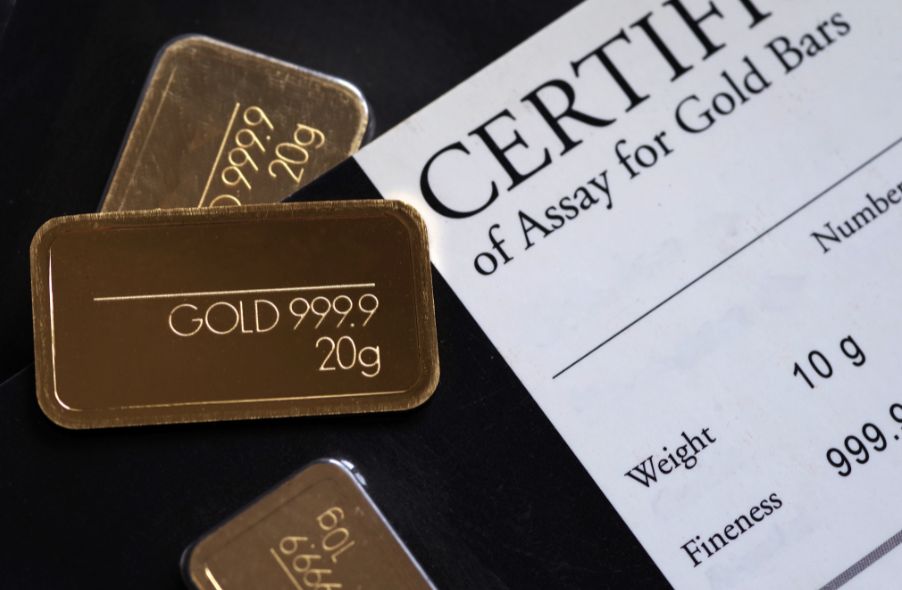
What is Paper Gold?
Investing in gold has been a popular choice for many individuals looking for a stable and valuable asset. However, the logistics and cost of storing physical gold bullion can be a deterrent for some investors. This is where paper gold comes in. Paper gold refers to any type of gold-backed asset that is tied to the spot price of gold but does not involve holding physical metal. It allows investors to enjoy the benefits of owning gold without the added costs of delivery, storage, and insurance.
Types of Paper Gold Investments
There are several types of paper gold investments available in the market:
Gold Exchange-Traded Funds (ETFs)
Gold-backed ETFs function similarly to traditional stocks. The value of these assets is tied to the price of physical gold, rising or falling accordingly. ETF shares can be easily bought and traded through brokers. When you invest in gold ETFs, you are essentially purchasing shares in the gold assets held by the fund. If you decide to liquidate your investment, you will not receive physical metal but rather the monetary equivalent of your shares.
Physical Gold Certificates
Gold investment certificates allow individuals to own physical gold without actually holding it. The physical metal is stored in a secure vault, and the authority issuing the certificates takes care of storage and security. Traditionally, banks and financial companies issue these certificates. Alternatively, individuals can purchase gold bullion online from reputable companies and allow the seller to handle storage. Online platforms also provide options for trading gold.
Gold Futures Contracts
Gold futures involve an agreement to purchase a specific amount of physical gold at a predetermined price and time in the future. Instead of immediate possession, investors receive the metal at a later date. Gold futures can be either short-term or long-term investments. Investors have the option to sell these contracts before receiving physical gold or wait until the agreed-upon date to take possession of the gold bullion.
Commodity Pools Accounts
Commodity pools are funds that pool and invest capital from multiple individuals or entities. These funds are managed by professionals and primarily invest in gold-backed securities. Commodity pools offer higher liquidity and streamlined management, making it convenient for investors looking for a low-maintenance investment setup.

The Benefits of Paper Gold
Investing in paper gold offers several advantages over physical gold:
Flexibility
Investors have the ability to invest any amount of money they desire into paper gold. In contrast, physical gold may require bulk purchases to make delivery and storage costs practical.
Liquidity
Converting paper gold investments, such as ETF shares or futures contracts, into cash is quick and convenient, especially when market conditions are favorable. Reputable stock exchanges or online platforms facilitate these transactions.
Lower Associated Costs
When investing in paper gold, individuals do not need to pay for shipping, secure storage vaults, or insurance. The only cost incurred is the broker's commission. In contrast, the costs of storing and insuring physical gold can accumulate over time.
No Storage Concerns
Investors do not need to worry about the loss or theft of their precious metals when investing in paper gold.
The Risks of Paper Gold Investment
Despite the advantages, there are some risks associated with investing in paper gold:

Dependence on Third Parties
Investors are reliant on the financial institution or fund that issued the gold-backed securities. If the organization encounters a crisis due to mismanagement or other factors, it could jeopardize the investment.
Valuation Gaps
Discrepancies may arise between the spot price of physical gold and the value of gold-backed assets due to tracking errors, management fees, and other factors.
Market Volatility
Some paper gold investments, such as gold futures, are more speculative in nature and may be more vulnerable to market fluctuations compared to physical gold.
No Physical Metal Ownership
Investors do not have the satisfaction and security of physically holding bullion when investing in paper gold.
Should You Invest in Physical Gold?
While paper gold offers convenience and flexibility, physical gold remains a popular choice for those seeking a safe hedge investment. Here are the benefits and drawbacks of investing in physical gold:
Pros of Physical Gold
- Ironclad Intrinsic Value: Physical gold's value depends less on third parties compared to gold-backed securities.
- Stability: Gold has held its value for centuries and will continue to do so even during economic downturns.
- Security: Physical gold is not vulnerable to hacking or cyber threats.
- Tradability: Gold bullion can be physically held and exchanged at any time and place, making it a readily accessible and tradable commodity.
Cons of Physical Gold
- Markup Prices: Purchasing gold bars or coins incurs a markup on top of the metal's spot price. Larger gold bars may have lower markups but can be more challenging to sell.
- Storage and Insurance Costs: Storing a significant amount of physical gold requires secure storage, which may involve annual fees. Insurance may also be necessary to protect the precious metal.
- Risks: Physical gold is susceptible to theft and damage from natural disasters, which could result in financial loss if not properly insured.
- Slower Liquidity: While physical gold is always in demand, selling bullion may take longer compared to trading ETF shares or digital gold assets. Dealer fees may also apply when selling gold bullion.
Factors to Consider When Choosing Between Paper Gold and Physical Gold
Investors do not have to choose between paper gold and physical gold exclusively. Diversifying one's investment portfolio allows for potential profits from gold-backed securities while still safeguarding wealth with physical gold during market crashes. Physical gold often appreciates in value during economic crises, while paper assets may depreciate.

Experienced investors with a significant amount of money and the ability to absorb potential losses may consider gold ETF shares or futures as viable options. Consulting an investment advisor is always recommended before making substantial investments in any gold venture.
For individuals who prioritize gold as the ultimate hedge investment and seek protection against market shifts, purchasing physical gold may be the preferred choice. Gold bullion serves as a safe haven asset that provides financial security during stock market crashes and can be a valuable asset for retirement planning and generational wealth preservation.
Choose Wisely When Investing in Paper Gold
If you decide to invest in paper gold, it is crucial to choose a fund that has full backing from physical gold. This helps reduce the risks associated with mismanagement or poor investment decisions. Additionally, researching past returns and associated management costs is essential when exploring different investment options.
Consider a Gold IRA
A Gold IRA combines the security of physical bullion with the convenience of paper gold. Certain self-directed IRAs allow individuals to hold physical precious metals like gold, silver, and platinum, in addition to precious metal shares and securities. Gold IRAs gained popularity after the
Frequently Asked Questions
What amount should I invest in my Roth IRA?
Roth IRAs let you save tax on retirement by allowing you to deposit your own money. These accounts are not allowed to be withdrawn before the age of 59 1/2. There are some rules that you need to keep in mind if you want to withdraw funds from these accounts before you reach 59 1/2. First, you cannot touch your principal (the original amount deposited). This means that you can't take out more money than you originally contributed. If you take out more than the initial contribution, you must pay tax.
The second rule is that your earnings cannot be withheld without income tax. Withdrawing your earnings will result in you paying taxes. Let's assume that you contribute $5,000 each year to your Roth IRA. Let's further assume you earn $10,000 annually after contributing. You would owe $3,500 in federal income taxes on the earnings. This leaves you with $6,500 remaining. The amount you can withdraw is limited to the original contribution.
You would still owe tax on $1,500 if you took out $4,000 of your earnings. You'd also lose half the earnings that you took out, as they would be subject to a second 50% tax (half of 40%). Even though you had $7,000 in your Roth IRA account, you only received $4,000.
There are two types if Roth IRAs, Roth and Traditional. Traditional IRAs allow pre-tax contributions to be deducted from your taxable tax income. Your traditional IRA allows you to withdraw your entire contribution plus any interest. A traditional IRA can be withdrawn up to the maximum amount allowed.
Roth IRAs are not allowed to allow you deductions for contributions. You can withdraw your entire contribution, plus accrued interests, after you retire. There is no minimum withdrawal limit, unlike traditional IRAs. It doesn't matter if you are 70 1/2 or older before you withdraw your contribution.
Can I hold a gold ETF in a Roth IRA?
Although a 401k plan might not provide this option, you should still consider other options like an Individual Retirement Account (IRA).
Traditional IRAs allow contributions from both the employer and employee. An Employee Stock Ownership Plan (ESOP) is another way to invest in publicly traded companies.
An ESOP provides tax advantages because employees share ownership of company stock and profits the business generates. The money invested in ESOPs is taxed at a lower rate that if it were owned directly by an employee.
An Individual Retirement Annuity (IRA) is also available. You can make regular payments to your IRA throughout your life, and you will also receive income when you retire. Contributions to IRAs can be made without tax.
What Should Your IRA Include in Precious Metals?
It's important to understand that precious metals aren't only for wealthy people. You don't have to be rich to invest in them. You can actually make money without spending a lot on gold or silver investments.
You may consider buying physical coins such as bullion bars or rounds. Also, you could buy shares in companies producing precious metals. You might also want to use an IRA rollover program offered through your retirement plan provider.
No matter what your preference, precious metals will still be of benefit to you. They offer the potential for long-term, sustainable growth even though they aren’t stocks.
Their prices rise with time, which is a different to traditional investments. If you decide to sell your investment, you will likely make more than with traditional investments.
What are the benefits of having a gold IRA?
The best way to save money for retirement is to place it in an Individual Retirement Account. It's tax-deferred until you withdraw it. You have total control over how much each year you take out. There are many types available. Some are more suitable for students who wish to save money for college. Others are intended for investors seeking higher returns. Roth IRAs, for example, allow people to contribute after they turn 59 1/2. They also pay taxes on any earnings when they retire. The earnings earned after they withdraw the funds aren't subject to any tax. This type of account might be a good choice if your goal is to retire early.
Because you can invest money in many asset classes, a gold IRA works similarly to other IRAs. Unlike a regular IRA which requires taxes to be paid on gains as you wait to withdraw them, a IRA with gold allows you to invest in multiple asset classes. This makes gold IRA accounts a great choice for those who want their money to be invested, not spent.
You can also enjoy automatic withdrawals, which is another benefit of owning your gold through an IRA. This eliminates the need to constantly make deposits. To ensure that you never miss a payment, you could set up direct debits.
Finally, gold is one the most secure investment options available. Because it isn't tied to any particular country its value tends be steady. Even in economic turmoil, gold prices tends to remain relatively stable. As a result, it's often considered a good choice when protecting your savings from inflation.
Statistics
- You can only purchase gold bars at least 99.5% purity. (forbes.com)
- Instead, the economy improved, stocks rebounded, and gold plunged, losing 28 percent of its value in 2013. (aarp.org)
- Contribution limits$6,000 (49 and under) $7,000 (50 and up)$6,000 (49 and under) $7,000 (50 and up)$58,000 or 25% of your annual compensation (whichever is smaller) (lendedu.com)
- If you take distributions before hitting 59.5, you'll owe a 10% penalty on the amount withdrawn. (lendedu.com)
- This is a 15% margin that has shown no stable direction of growth but fluctuates seemingly at random. (smartasset.com)
External Links
cftc.gov
forbes.com
- Gold IRA – Add Sparkle to Your Retirement Nest Egg
- Understanding China's Evergrande Crisis – Forbes Advisor
law.cornell.edu
- 7 U.S. Code SS7 – Designation of boards for trade as contract markets
- 26 U.S. Code SS 408 – Individual retirement account
bbb.org
How To
3 Ways to Invest Gold for Retirement
It is important to understand the role of gold in your retirement plan. You have many options for investing in gold if there is a 401K account at your workplace. You might also be interested to invest in gold outside the workplace. You could, for example, open a custodial bank account at Fidelity Investments if your IRA (Individual Retirement Account) is open. If you don't have any precious metals yet, you might want to buy them from a reputable dealer.
If you do invest in gold, follow these three simple rules:
- Buy Gold with Cash – Avoid using credit cards or borrowing money to fund investments. Instead, cash in your accounts. This will protect your against inflation and increase your purchasing power.
- Physical Gold Coins You Should Buy – Physical gold coins should be purchased over a paper certificate. Physical gold coins are easier to sell than certificates. Physical gold coins don't require storage fees.
- Diversify Your Portfolio. – Do not put all your eggs into one basket. By investing in multiple assets, you can spread your wealth. This can reduce market volatility and help you be more flexible.
—————————————————————————————————————————————————————————————-
By: Learn About Gold
Title: Investing in Gold: Paper Gold vs. Physical Gold
Sourced From: learnaboutgold.com/blog/paper-gold/
Published Date: Wed, 10 Jan 2024 23:00:55 +0000




















